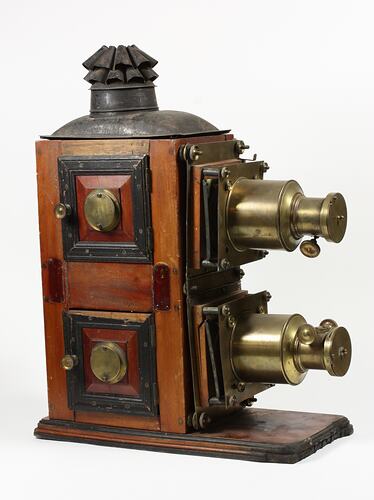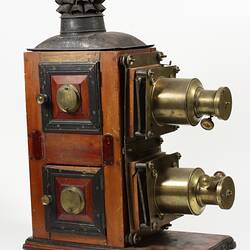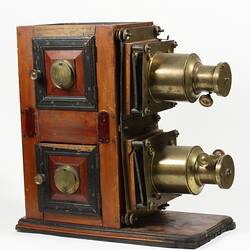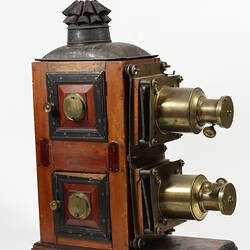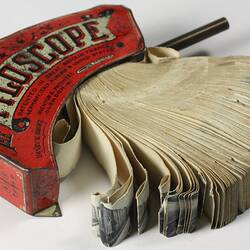Summary
Incomplete wood and brass projector was used to view lantern slides. It is of rather crude workmanship, with visible screws used to put the panels together. It is by an unknown maker.
It is believed that the biunial was first conceived by E.G. Wood who was partner with the London instrument makers Horne and Thornthwaite until he left in 1855, The biunial lantern is a system of projection where two lanterns are inbuilt, one on top of the other. This form of projection became possible once the more powerful limelight illuminants were used and quickly became popular. By 1888 it was recorded that over 60 models were being produced, presumable in Britain. The biunial allowed for special effects such as dissolving views to be created by adjusting the brightness of the illuminant in each system.
While the invention of the magic lantern is generally seen to be in the 17th century, its greatest popularity as an optical projector spans the late 18th century to the early decades of the 20th century. It was used both as a means of entertainment and education.
This lantern projector is part of the Francis Collection of pre-cinematic apparatus and ephemera, acquired by the Australian and Victorian Governments in 1975. David Francis was the curator of the National Film and Sound Archive of the British Film Institute as well as being a co-founder of the Museum of the Moving Image in London, which was operational between 1988 and 1999.
Physical Description
Biunial lantern with wooden body and brass detailing. X2 complete pinion and rack lens tubes. Condensers x2 insitu. Some oxidation to brass front plates. Both lateral sides have x1 hinged side-swing door into top and bottom illumination chambers (ie 2 each side). Each door features circular blue glass viewing hole with brass frame and brass swing cover. Frame detailing to lower door on right lateral side split at handle. Top frame detailing of same door split and missing. Rectangular wooden base plate is damaged to the front and right lateral corner. Right lateral side is missing handle and front and back handle holders. Left lateral side is missing handle and front handle holder. Back brass handle holder insitu. Two wooden handle rods and x3 brass handle holders loose within lower illumination chamber. Metal roof and chimney/cowl missing. Back wall of lantern chamber features x2 A shaped apertures leading into top and bottom illumination chambers. Interior of illumination chambers (top/bottom) metal lined. Each illumination chamber has metal floor with side runners for sliding in illuminants. Illuminants are missing.
More Information
-
Collection Names
-
Collecting Areas
-
Acquisition Information
Loan & Subsequent Donation from Australian Film Institute (AFI), Mr David Francis, by Nov 1990
-
Collector
Mr David Francis, London, Middlesex, England, Great Britain, 1990
-
Date Made
-
Classification
Communications, Audio-visual technology, Image production equipment
-
Category
-
Discipline
-
Type of item
-
Overall Dimensions
500 mm (Length), 210 mm (Width), 460 mm (Height)
-
References
[Book] Robinson, David, et al. 2001. Encyclopaedia of the Magic Lantern., 2001, 39-40 Pages
-
Keywords
Lantern Projectors, Magic Lanterns, Pre-Cinema Moving Images, Projectors
